More effective methodologies replace what used to work 10 years ago
One should think of an organisation's system as a complex network of smaller and larger gears. There are massive nodes and more isolated parts that are further apart. In fact, maximising organisational efficiency is about ensuring each gear is optimally positioned and is perfectly compatible with all of the adjacent cogs, so that the whole can function smoothly and without any jamming.
"People first" - Wise leaders invests in their people
Peerformance is first and foremost about ensuring that the most important and noble "gears", notably people in the organisation, can perform their tasks in a mutually supportive, complementary and harmonious way. That will lead on to a kind of unity which is unquestionably more than the sum of its parts.
Our tools and methods use data as a basis to analyse the relationships between individuals, teams, divisions and organisations as a whole. 300 fortune 500 listed large companies have already chosen TTI's assessment-based organisational development system to guide their organisational effectiveness strategy.
Our tools and methods help you:
- Develop leadership, group and organizational effectiveness
- Create your strategy of organizational strategy
- Design individual career paths and increase commitment
- Develop leadership skills and competences
- Improve internal dynamics and efficiency in your team
- The entire HR system starting with recruitment and selection processes
Issues emerging in an existing system
Recruitment and selection, although critical, are only the first step in organisational development.
Are staff and managers capable enough to perform their tasks well or excellently? Is there something in common among those who excel in the same job? What about average performers? Could they do better in a different position or in a different environment? Who are the underachievers and what might be the reasons? These are some of the questions we can answer.
Talent map - shows where talented people are?
A talent map is an accurate representation of the distribution of talent within an organisation. The conclusions drawn from a talent map are mostly useful in the following areas:
- achieving organisational goals set along KPIs
- defining individual career paths
- building high performance teams
- optimising talent management processes.
A good leader is not the same as a good professional
It is not easy to be a leader. Often not even for those who seem to be born leaders. Several managers are appointed to leadership positions because of their years of experience, solid expertise in the field and loyalty to the firm. But leadership requires more than that.
First of all good leaders treat their people as they treat themselves. They lead by example and contribute to the success of their organisation or team by doing their best. To do this, they must be perfectly aware of their own qualities to know where they excel and where they need to work the hardest. Their ultimate goal should be to find a style that offers them the greatest comfort and brings maximum motivation for their team. We help you with this.
The whole is more than the sum of its parts - what makes a team?
Inefficient environments can drag down the performance of even the most outstanding professional while a well-functioning system can help average performers reach outstanding levels. An inclusive environment is a must for human talent to flourish. Your outstanding score on maths test offers no guarantee that you will perform well as a team member in an engineering company.
TTI tests can help your teams become more than the sum of their parts. A good team can achieve more than the sum of the skills of all the individuals in it.
Increasing satisfaction and engagement
Staff turnover can be minimised in organisations where all people are at the right place, where we know what motivates and what satisfies each individual. Some surveys suggest more than two thirds of employees change jobs because of their immediate work environment - their team or the manager they report to.
How many of these talents could be retained and how much HR effort and financial resources could be saved by using the right tools to keep retention properly in focus?
We make no secret about this: A lot.





















